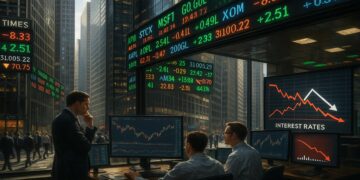How Labor Market Fluctuations Affect Investment and Consumption in the USA

Understanding Labor Market Dynamics
Understanding the dynamics of the labor market is crucial for grasping the broader economic landscape in the United States. Labor market fluctuations—essentially changes in employment rates, wages, and job availability—can greatly influence both investment and consumption. These fluctuations are interconnected with various economic indicators and reflect the overall health of the economy.
Key Factors in Labor Market Fluctuations
To delve deeper into how the labor market affects economic activity, it is essential to consider a few key factors:
- Employment Levels: High employment rates indicate that a significant portion of the population is earning wages, which often leads to increased consumer spending. For instance, when the unemployment rate is low, individuals feel more secure about their jobs and are more likely to make significant purchases, such as homes or cars.
- Wage Growth: As wages rise, individuals enjoy increased disposable income. This boost in income allows people to spend more on goods and services, which, in turn, can stimulate the economy. A notable example is the period following the implementation of higher minimum wage laws in certain states, where local economies saw a surge in consumption as workers had more money to spend.
- Investor Confidence: A robust labor market can instill confidence in investors. When companies are hiring and expanding their workforce, it signals strength in economic activity. For instance, during times of low unemployment, stock markets often thrive because investors anticipate higher company profits resulting from increased consumer spending.
The Impact of Labor Market Challenges
Conversely, when the labor market faces challenges, such as a spike in unemployment, the effects can be detrimental:
- Reduced Spending: High unemployment rates can lead to a decrease in consumer confidence. As individuals fear losing their jobs, they may curtail spending and save more. This cautious behavior can have a ripple effect, where businesses experience declining sales and might need to scale back operations.
- Investment Withdrawal: Investors may become hesitant to commit capital during uncertain economic times. A high unemployment rate can signal potential risks to investments, prompting investors to hold back or seek safer avenues. For instance, during the 2008 financial crisis, many investors retreated from the stock market due to fears about an unstable labor market.
- Business Adjustments: Companies often make strategic adjustments in response to labor market fluctuations. If they perceive a decline in consumer demand due to increased unemployment, they may delay expansion plans or minimize hiring, which can create a cycle of economic stagnation.
Conclusion
This article aims to explore how fluctuations in the labor market directly impact both investment decisions and consumer choices. By analyzing this relationship, we can better understand the intricate web of factors that shape economic activity in the USA. Understanding these principles not only helps individuals and businesses navigate changing economic conditions but also empowers them to make informed decisions affecting their financial future.
DIVE DEEPER: Click here for the step-by-step guide
The Connection Between Employment Rates and Economic Activity
The relationship between employment rates and economic activity in the United States is deeply interwoven. A strong labor market not only boosts consumer confidence but also lays a foundation for robust investment. When employment levels are high, consumers tend to feel more secure in their financial situations, which translates to a willingness to spend. This phenomenon can be seen during periods of economic expansion, where rising employment correlates with increased retail sales and service consumption.
Consumer Spending in a Thriving Labor Market
In a thriving labor market with low unemployment rates, the ripple effects are evident in consumer behavior:
- Increased Disposable Income: With more people earning wages and benefiting from job stability, disposable income typically rises. When individuals have more funds available after necessary expenses, they are more likely to indulge in discretionary spending. For example, people are more inclined to plan vacations, dine out frequently, or invest in luxury items when they perceive stability in their jobs.
- Enhanced Confidence and Future Spending: Job security plays a significant role in consumer mindset. When employees feel secure in their positions, they are more likely to make large purchases. This might include buying a new car or upgrading their homes. Such spending not only boosts individual finances but also propels industries forward, leading to increased hiring and investment opportunities.
- Impacts on Real Estate: The housing market often reflects labor market dynamics closely. During periods of low unemployment, more individuals can qualify for home mortgages given their stable income, which drives up demand for housing. Consequently, homebuilders may respond by investing in new construction projects, leading to job creation in that sector as well.
The Role of Wage Growth
Wage growth is another critical component of labor market fluctuations that impacts consumption and investment. As wages increase, consumers are typically encouraged to spend more:
- Boosting Consumer Spending: Higher wages mean higher purchasing power, which translates directly into increased spending on a variety of goods and services. An excellent illustration is seen when states raise their minimum wage laws. In many instances, the local economies experience an uptick in economic activity thanks to the newfound disposable income of lower-wage workers.
- Catalyzing Investments: When businesses recognize that their employees have more disposable income, they may be prompted to invest in new projects or expand operations. This includes both growth initiatives within existing companies and decisions by new businesses to enter the market. As the workforce’s purchasing power increases, the demand for products and services grows, motivating companies to invest in meeting that demand.
In summary, a vibrant labor market characterized by high employment and wage growth directly propels consumer spending and influences investment decisions across the economy. This interconnectedness illustrates how crucial a stable labor market is for fostering economic growth and prosperity in the United States.
DISCOVER MORE: Click here for insights on protecting yourself from cryptocurrency scams
The Influence of Labor Market Conditions on Business Investment
The fluctuations in the labor market not only affect consumer spending but also have profound effects on business investment decisions. Companies are constantly evaluating their workforce needs in relation to consumer demand, and these assessments can shift based on employment trends.
Investment Decisions in Response to Labor Market Strength
Favorable labor market conditions often lead businesses to invest in expansion and development:
- Increased Hiring and Workforce Expansion: When unemployment rates are low, companies may find themselves competing for a limited pool of skilled workers. To attract top talent, businesses often enhance their compensation packages and benefits, thereby increasing their operational costs. However, the trade-off can be a higher level of productivity, as a motivated workforce contributes significantly to the bottom line.
- Capital Expenditures: In a flourishing labor market, firms may ramp up their capital expenditures, investing in new technology, facilities, or equipment to bolster productivity. For instance, consider a manufacturing company that, perceiving a rise in demand for its products due to increased consumer confidence, decides to automate certain processes. This investment not only enhances efficiency but also results in job creation as the need for skilled technicians grows.
- Research and Development (R&D): The confidence stemming from a robust labor market propels businesses to allocate funds for R&D. Companies are more likely to innovate and develop new products when they feel assured about their sales and profitability. For example, a technology firm may invest heavily in developing promising software applications, anticipating that a stronger economy means more consumers will seek their solutions.
Business Sentiment and Economic Cycles
Business sentiment often mirrors labor market conditions, impacting investment strategies significantly:
- Optimism in Times of Growth: When the labor market is thriving, businesses might undergo internal evaluations to project future growth. Positive employment trends lead to optimism, encouraging companies to undertake long-term projects. For instance, a restaurant chain may choose to open new locations based on the belief that consumer spending will continue to rise because of strong employment figures.
- Investment Hesitation During Uncertainty: Conversely, when unemployment rises or there are signs of economic instability, businesses may hold off on large investments. For instance, a construction company may delay new projects if they sense that a recession might be looming, as this could lead to lower demand for housing and commercial properties.
This cyclical relationship between labor market conditions and business investment highlights how integral employment levels are to the broader economic ecosystem. An investment climate bolstered by low unemployment can create a self-reinforcing cycle: increased investment stimulates job creation, which, in turn, further fuels consumer spending and confidence. Understanding this dynamic is crucial for policymakers and business leaders alike, as it can inform strategies that foster sustained economic growth.
DIVE DEEPER: Click here to discover essential tools for boosting your productivity
Conclusion
In summary, the intricate relationship between labor market fluctuations, investment dynamics, and consumer behavior is essential for understanding the broader economic landscape in the USA. As we have explored, strong labor market conditions tend to spur business investments, which leads to increased hiring, innovative research, and development. This not only fosters a cycle of economic growth but also builds consumer confidence, prompting households to increase their spending. The resulting boost in demand can further drive businesses to expand and invest.
Conversely, during periods of labor market uncertainty or rising unemployment, we witness companies becoming more cautious and often postponing significant investments. This hesitation can create a ripple effect, diminishing consumer spending and potentially leading to an economic slowdown. It is clear that fluctuations in employment levels serve as a critical indicator for both businesses and policymakers, influencing critical decisions that shape the economic outlook.
As we move forward, understanding these nuanced interconnections can help us formulate better economic strategies. By recognizing the importance of supporting a stable labor market, we can cultivate conditions that favor sustained investment and consumption growth. Ultimately, a robust labor market not only benefits individual workers but serves as the foundation for a thriving economy that can withstand fluctuations and foster prosperity for all.

Beatriz Johnson is a seasoned financial analyst and writer with a passion for simplifying the complexities of economics and finance. With over a decade of experience in the industry, she specializes in topics like personal finance, investment strategies, and global economic trends. Through her work on Happy Receitas, Beatriz empowers readers to make informed financial decisions and stay ahead in the ever-changing economic landscape.





